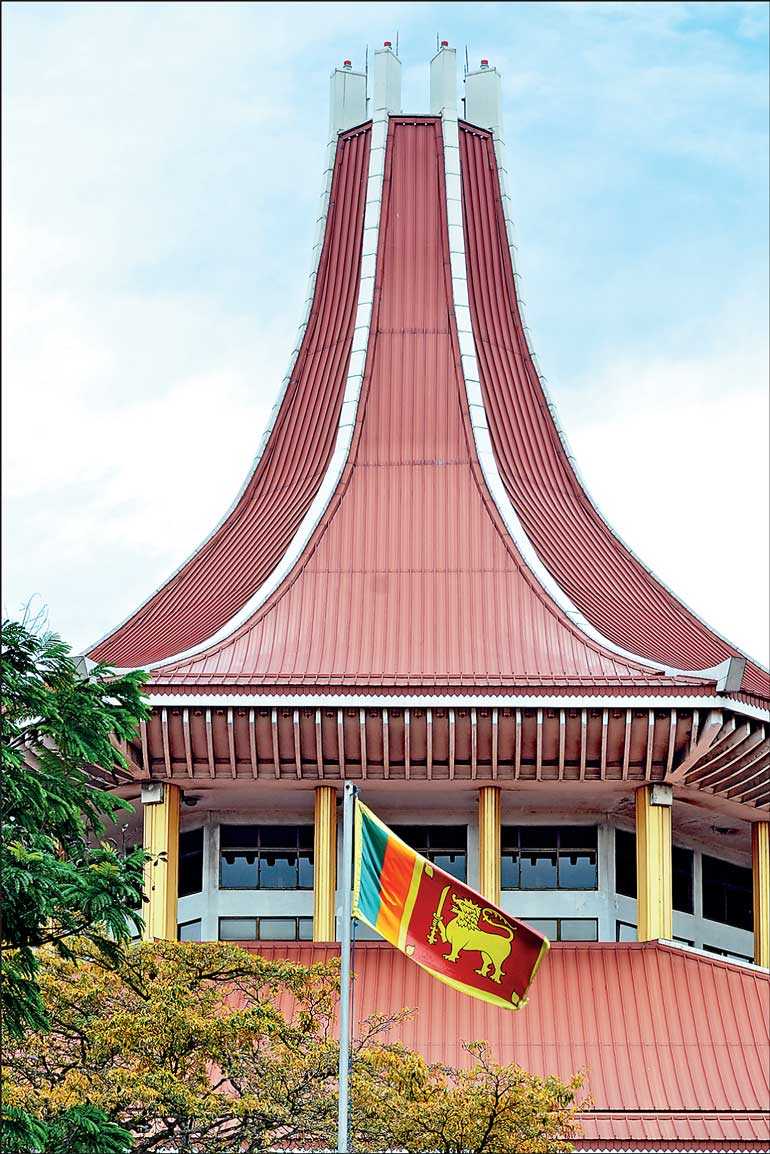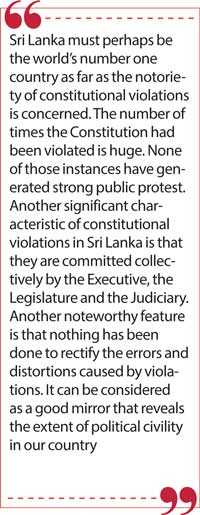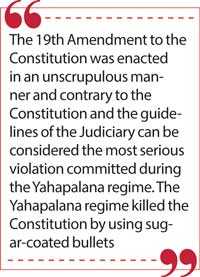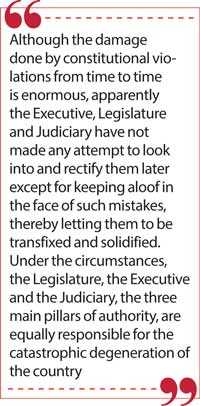Thursday Jan 23, 2025
Thursday Jan 23, 2025
Friday, 24 January 2020 00:00 - - {{hitsCtrl.values.hits}}

The lack of advanced political consciousness and democratic discipline can be considered as one of the main reasons for the crisis and the failure that Sri Lanka is facing. This can be considered a situation that has prevailed since independence.
Sri Lanka gained independence without having to make a serious social struggle for it. None of the pioneering political leaders who emerged when Sri Lanka entered the modern age had any knowledge or deep understanding of liberal political ideologies. Although there are hundreds of books on Marxism published in Sinhala, not a single book of classical liberal philosophers has been translated into Sinhala so far.
At the end of the the ’80s, Dr. Chanaka Amaratunga founded a political party called the Liberal Party, but it remained a movement limited only to a small number of English-speaking people. Several leaders of the Ceylon National Congress were educated in the West. But, there wasn’t a single leader among them who had a clear understanding of the liberal theories. Even Ponnambalam Arunachalam, the most educated among them, cannot be considered a liberal leader.
The LSSP
The political movement launched by the LSSP had the best assortment of intellectuals of the day. According to Mick Moore, the LSSP constituted a movement of intelligent and learned men. They were a group of internationalists. Many of them were educated overseas. Some of them were married outside their caste or community.Otherwise, they were descendants of mixed marriages. The majority of them belonged to non-Govigama castes and didn’t have much faith in religious beliefs and observances.
Apart from being intellectually eminent, they formed a group of talented leaders, eloquent speakers and experts in parliamentary system of governance. However, the most unfortunate thing about them was that they comprised a group of Marxists, not liberals. They perceived the State and the Parliament the way Marx or Lenin had perceived them. They considered class, not nation, as the most important thing.
Anagarika Dharmapala can be considered the person who most influenced the thinking of Sinhalese people. Arumugam Navalar made a similar influence on Tamil society. Though Dharmapala and Navalar have been viewed by the Sinhalese and Tamils, respectively, as great leaders, they can be considered as diminutive personalities when compared to the intellectual vision of the leaders of the calibre of Ram Raj Mohan Roy and Ahmed Khan of the Indian religious revivalist movement.
It is the independence movement that took the religious revivalist movement in India to a final conclusion after it had fulfilled the role of expanding the horizons of the social psyche of the Indian people. It can be regarded as the movement that conveyed democracy and democratic values to the Indian people. It can be described as a movement fully devoted to secularism and was engaged in a powerful ideological struggle against all forms of ethnic, religious and caste differences.
Although Gandhi had a strong religious side, he, in fact appeared for a secular state, and not for a religious state. He believed that religion is not a subject to be taught in school and maintained that religious education must be the sole concern of religious associations.
Intellectual poverty
The independence movement of Sri Lanka was not guided by a far-reaching vision. It hardly made an intellectual impact on social psyche.The Indian Freedom Movement had a Human Rights Charter in 1936. At that time there was no UNO. 
D.S. Senanayake got the Constitution of independent Sri Lanka, which was to be submitted to the Whitehall authority, drafted by Sir Ivor Jennings. It is said that D.S. Senanayake was opposed to the inclusion of a Human Rights Charter into the draft of the Constitution.If G.G. Ponnambalam had a good understanding of the significance of having a Human Rights Charter, perhaps, he would have asked for a Human Rights Charter instead of demanding 50-50 status of representation.
India was aware of human rights as far back as 1936.It was only in the ’70s that Sri Lanka began to talk on human rights.
This illustrates the gap that prevailed between Sri Lanka and India as far as political consciousness is concerned. If Sri Lanka possessed an advanced political consciousness similar to that which prevailed in India during and after the independence struggle, it would probably have been possible to resolve the issues of race, caste and religion by developing an advanced Charter on Human Rights. The backwardness of political consciousness had its adverse impact not only on the political leaders of all kinds, but also on the State and its institutions, and in particular the judicial system of Sri Lanka.
A clear understanding of liberalism is necessary because the modern democratic system of governance and all that is associated with it is dependent on liberal concepts. Even the modern constitution is a creation of liberalism. In that sense, despite the capitalist aspects of it, liberalism can be considered the political doctrine of democracy.
Although the people of Sri Lanka were able to talk about Russian, Chinese and Cuban Revolutions by memory, they were not adequately aware of the English, American or the French Revolutions except the information available in common history books. Although there are many books written in Sinhala or translated into Sinhala on the first category of revolutions mentioned above, there is hardly any book written in Sinhala or translated into Sinhala on the second category of revolutions. Even scholars like Martin Wickremesinghe have written about Marxism and Socialism, but not on Liberalism. This intellectual deficiency had been a significant factor affecting the failure of Sri Lanka.
The Constitution
In a political sense, civilised countries regard the constitution as something sacred that must be protected with extreme respect and care. Violation of the constitution is deemed a horrific crime analogous to grave offences such as mass murder. In the event of violation, on rare occasions, of the constitution or traditions of good governance, civilised countries tend to take action to rectify the error as soon as possible.
In 1976, Indira Gandhi, Prime Minister of India, using her majority power in Parliament enacted the 42nd Amendment, changing the structure and the spirit of the Indian Constitution. Despite strong objections from the Judiciary, Indira Gandhi managed to resist them and achieve her objective. 
This serious act of Indira Gandhi came under vehement protest of Indian society and had a crucial impact on the defeat of her Congress party in the 1977 election. The Janata Party which succeeded her rule enacted 43rd and 44th Amendments in 1977 and 1978 respectively, to rectify the distortion and contradictions in the constitution, caused by the 42nd amendment. At the same time, the Supreme Court of India issued a ruling, outlawing the amendments to the constitution by ruling parties, which are likely to change the vision and the basic structure of it. Though this decision reached by a panel of 13 judges of the Supreme Court of India came under strong protest of the rulers, so far, none of them had been able to change it.
It is the Supreme Court that should act as the guardian angel of the constitution. It can be said that the Supreme Court of India has performed its duty perfectly and to the letter in discharging its responsibility.
Constitutional violations
Perhaps, Sri Lanka must be the world’s number one country as far as the notoriety of constitutional violations is concerned. The number of times the Constitution had been violated is huge. None of those instances have generated strong public protest.
Another significant characteristic of constitutional violations in Sri Lanka is that they are committed collectively by the Executive, the Legislature and the Judiciary. Another noteworthy feature is that nothing has been done to rectify the errors and distortions caused by violations. It can be considered as a good mirror that reveals the extent of political civility in our country.
The first constitutional violation occured in 1956 with the enactment of the Sinhala Official Language Act. Section 29 (111) of the Soulbury Constitution had prevented enactment of discriminatory laws to the advantage or disadvantage of any ethnic or religious group/s. It is not possible that Prime Minister Bandaranaike was unaware that he was violating the Constitution in enacting the Official Language Act. It is also not possible even the Attorney General and the Speaker were not aware of it.
A Tamil clerk named Kodeshwaran, who failed the Sinhala Language Proficiency Test after the enactment of the Sinhala Official Language Act, filed a case in the District Court challenging the Official Language Law and for depriving him of his promotions and salary increments. The State Counsel argued that a government servant cannot take legal action against the State and therefore the case should be dismissed. However, the District Judge gave a ruling in favour of Kodeshwaran, but the Attorney General challenged the ruling of the District Judge and carried the case to the Court of Appeal which eventually abdicated the decision of the District Judge. The plaintiff, with the assistance of the Federal Party, took the case to the Privy Council. The Privy Council ruled out that the Sinhala Official Languages Act was against the Constitution.
Even after the verdict of the Privy Council, the language policy which was contrary to the Constitution was not changed. Instead, it was incorporated into the 1972 Constitution. It was J.R. Jayawardene who eventually corrected this error. By Articles 18 and 19 of the 1978 Constitution, JR granted Sinhala and Tamil languages official language status and also national language status to both languages. However, the mistake was corrected only after the Tamil youth had plunged into a stance of fighting for a separate Tamil Eelam.
The patriots of Sinhala language who advocated a Sinhala Only policy did not challenge this change made by J.R. Jayewardene. Had it been possible for this error corrected earlier and also had the Judiciary performed its responsibility correctly when the matter was brought before the Court, perhaps it would have been possible to avert the outbreak of the protracted insurgency launched by the Tamil youth.
J. R. Jayewardene
The next major violation of the Constitution of Sri Lanka took place during the regime of President J.R. Jayewardene. Using the five-sixths majority he had in Parliament, President Jayewardene passed a constitutional amendment to extend the term of office of the incumbent Parliament for another six years. This he achieved through a corrupt referendum.
This unconstitutional action can be seen as an important factor in plunging the country to violence. If, as per the Constitution, a General Election was held instead of the corrupt referendum, the representation of Opposition parties in Parliament, including that of the JVP, would have increased thereby reducing the chances of them (JVP) moving towards a revolutionary and violent path.
Similarly, the political movements of youth in the north which had been moving towards violent paths could have been defeated by the democratic Tamil political movements; and some of them who had chosen the violent and rebellious path would have entered into the mainstream of the parliamentary system. In that sense, the 4th Amendment can be said to have been the source or the mother of the two horrific rebellions that broke out in the south and the north.
The Judiciary is also responsible for allowing this unconstitutional amendment. Three members of the panel of judges, including the Chief Justice, decided that this amendment was contrary to the Constitution, but the remaining four members allowed the amendment that plunged the country into violence. It can be described as a tragic instance in which the Constitution had been corrupted by the guardian angel himself who is supposed to defend and safeguard the Constitution.
Ranasinghe Premadasa
The petition filed against the election of Ranasinghe Premadasa as the President of Sri Lanka can be considered a major event in which the President had evinced a greater concern in the Judiciary. The Presidential Election in 1989 was held in a tense atmosphere in which the JVP, which was engaged in a violent upheaval, had proscribed the election. As such, the election was held in an atmosphere of violence and bloodshed. A significant number of people who worked for election had been killed. The rate of voting had fallen drastically. Polling was not held in a large number of polling centres.
The conduct of the election despite the ban imposed by the insurgents may be considered a good thing. But, the Judiciary, in considering the election petition, except for adopting a policy of safeguarding the position of the winner, does not seem to have given adequate attention to the fact that the conduct of an election in a violent atmosphere cannot be a just and fair election.
If the Judiciary, instead of safeguarding the position of the winner, had decided to hold a fresh election, taking into account the peaceful atmosphere that prevailed in the aftermath of the defeat of the JVP rebellion, whoever wins it, it might have strengthened the democratic institutional system of the country. Perhaps, it might have prevented the brutal assassinations of President Premadasa and Lalith Athulathmudali. Moreover, the precedent set by the Judiciary in regard to this petition has indeed made it extremely difficult for a petition to be won against a president.
Creation of a system whereby the Opposition MPs could join the Government without losing the parliamentary seat can be considered as one of the worst and most dangerous constitutional violations committed during the regime of Chandrika Bandaranaike which she was able to establish with the support of Chief Justice Sarath Nanda Silva. This atrocious act can be said to have distorted the system of governance and the Constitution, completely undermining its foundation.
The unlawful and crude procedure adopted to remove Shirani Bandaranayake, the first woman Chief Justice of Sri Lanka, from her office and the rejection of the Writ of Certiorari granted by the Court of Appeal quashing the inquiry by a Parliamentary Select Committee can be described as the most horrendous constitutional violation committed during the regime of Mahinda Rajapaksa. Even during the monarchical rule in England, the kings respected the Writs granted by the Court.
The 19th Amendment to the Constitution was enacted in an unscrupulous manner and contrary to the Constitution and the guidelines of the Judiciary can be considered the most serious violation committed during the Yahapalana regime. The Yahapalana regime killed the Constitution by using sugar-coated bullets.
Although the damage done by constitutional violations from time to time is enormous, apparently the Executive, Legislature and Judiciary have not made any attempt to look into and rectify them later except for keeping aloof in the face of such mistakes, thereby letting them to be transfixed and solidified.
Although the Judiciary has a responsibility for dismissing illegal and unconstitutional lawsuits that will lead to setting wrong precedents, it must be said that no Chief Justice or Attorney General has shown any interest in doing that. Under the circumstances, the Legislature, the Executive and the Judiciary, the three main pillars of authority, are equally responsible for the catastrophic degeneration of the country.